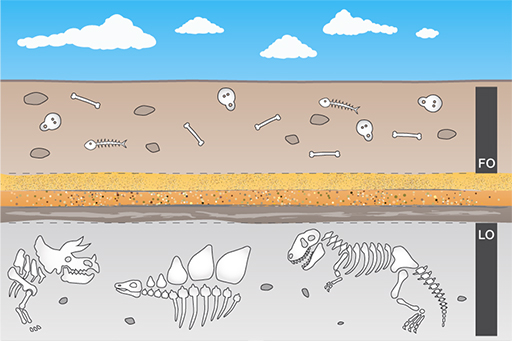3.11 Biostratigraphy
Back in Week 1, you learned about the importance of geological time and a few of the ways we have of figuring out which rock is older than another rock.
One way of figuring out the relative and absolute ages of rocks in the ground is the fact that different age rocks have different fossils in them.
For example, you never find fossilised humans (Homo sapiens) and fossilised dinosaurs in the same rock. The dinosaurs were wiped out 66 million years ago, whereas the earliest humans only appear 195,000 years ago. So, if you find a rock with a dinosaur in it, then you know it’s older than 66 million years old, whereas if you find Homo sapiens fossils, you can be sure that the rock is younger than 195,000 years old. This concept is known as biostratigraphy, and these two sorts of markers (or ‘datums’) described here are the last occurrence (LO) for the dinosaurs and the first occurrence (FO) for the human bones.

Why does any of this matter for oil exploration? Well, once you have an idea of the structure of an area from seismic exploration (and therefore know where oil and gas might be trapped), you need to know whether the rocks are likely to be the sort of rocks which are known (from elsewhere) to form good source, reservoir or trap rocks. One way you can figure that out is by knowing their age.
The kind of holes you can drill from an oil rig are too small to bring up whole dinosaur bones, but fortunately there are useful, tiny microfossils which are only a few tenths of a millimetre in size, hundreds of which can be seen in the drill cuttings which are recovered during drilling.
